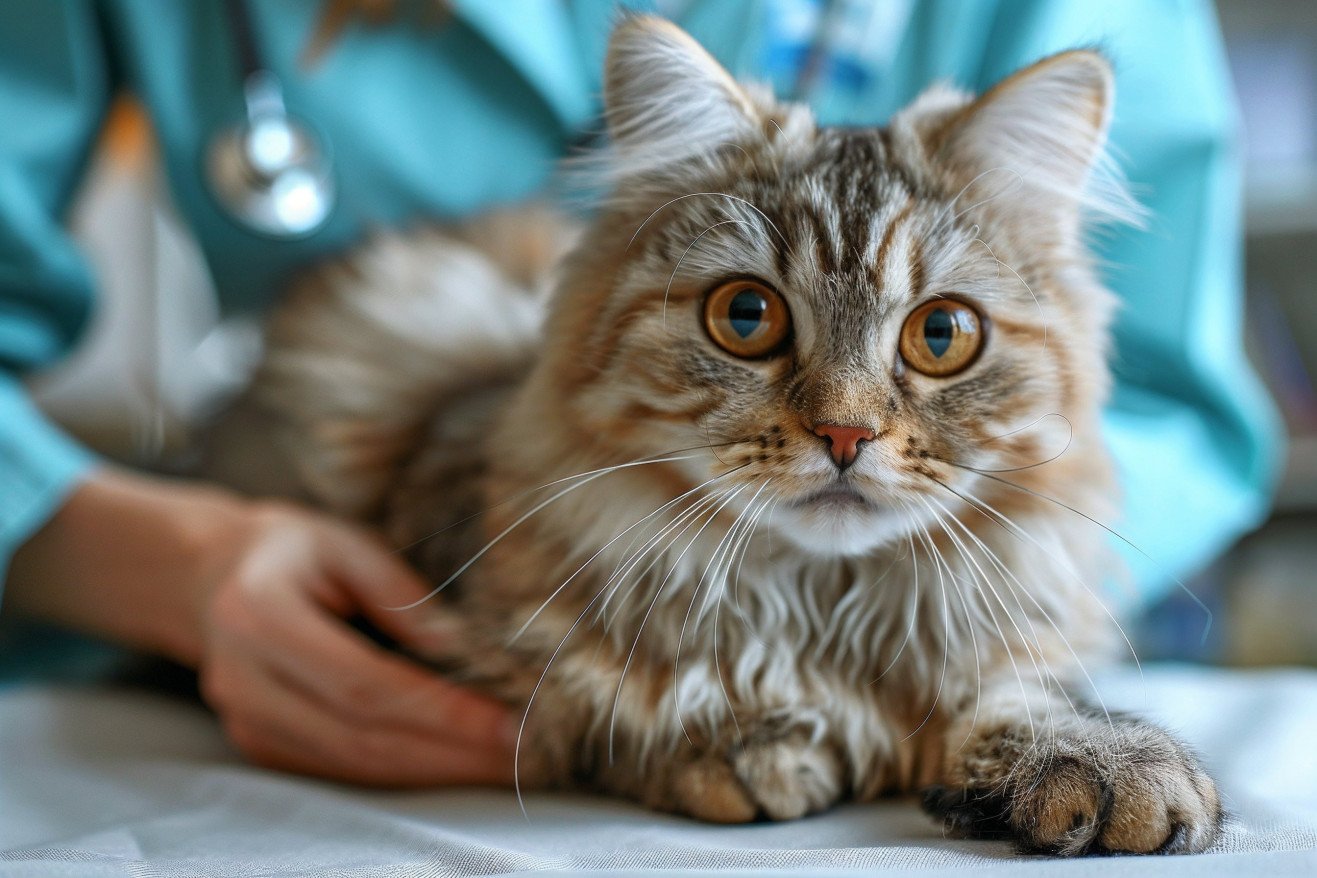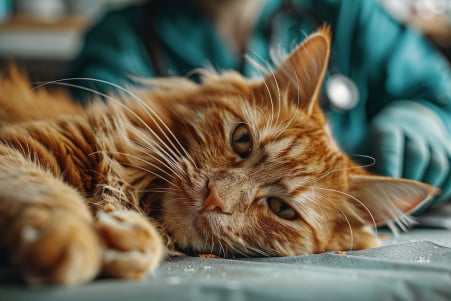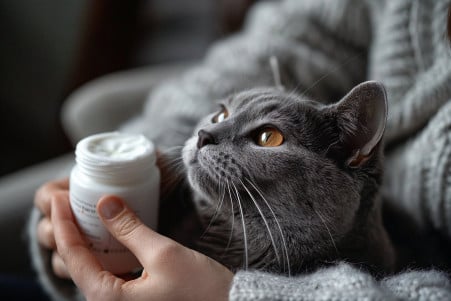Bee Stings on Cats: Signs, Treatment, and How to Prevent
12 March 2024 • Updated 11 March 2024

It’s a beautiful day, and your cat is outside, pawing at something—could it be a bee? When bees sting cats, the cats may experience pain, swelling, and tenderness at the sting site. Severe allergic reactions, although rare, can occur. It is crucial to immediately remove the stinger and monitor the cat for allergic symptoms. If severe reactions or persistent swelling occur, consult a veterinarian.
In this article, we will take a closer look at the impact of bee stings on cats, drawing from a variety of veterinary and animal behavior studies. This will include an overview of the physiological impact of bee venom on cats, the best ways to administer first aid, and the behavioral changes cats exhibit after being stung.
We will also cover how to prevent your cat from getting stung in the first place, so you can be sure you have all the information you need to keep your cat out of harm’s way.
How can you prevent bee stings on cats?
How to Tell If Your Cat Has Been Stung by a Bee
The physical signs of a bee sting on a cat are pretty easy to spot. According to a report by VCA Animal Hospitals, common symptoms include swelling and pain, and these symptoms are often localized to the face, ears, or paws, which are the most likely places for an insect to sting.
The Wildest explains that other signs, like behavioral changes (e.g., excessive licking, limping, or pawing at the affected area), can also be a sign that your cat is uncomfortable and possibly in pain.
One of the more concerning reactions to look out for is an allergic reaction. According to a report by My Family Vets, severe allergic reactions can include symptoms like difficulty breathing, drooling, and even collapse.
If your cat is experiencing these symptoms, they need to be seen by a vet right away. That said, you should also keep an eye on your cat for less severe but still concerning symptoms, like swelling that doesn’t go down or signs of anaphylaxis, like hives, restlessness, or gastrointestinal distress, according to VCA Animal Hospitals.
This will help you determine if your cat’s reaction is mild and will go away on its own or if it’s severe and requires medical attention.
You can help ensure your cat’s well-being by responding quickly and appropriately to their symptoms. Once you’ve identified the symptoms, you can then provide your cat with first aid to help them feel better.
Buzzing Concerns: First Aid and Treatment for Cat Bee Stings
Taking action as soon as possible after your cat has been stung can help to minimize their discomfort and any potential health issues. VCA Animal Hospitals advises that if you can see the stinger, you should try to remove it by scraping it off with a credit card or something similar to prevent more venom from being released.
It’s important to note that you should not use tweezers to remove the stinger, as this can cause more venom to be released.
To help with pain and swelling, Hills Pet recommends applying a cold compress or ice pack to the sting site to help reduce swelling. You’ll want to make sure that you only leave the compress on for a short period of time so that you don’t cause your cat any additional discomfort.
Do not give your cat any over-the-counter pain medications without first consulting your vet, as many human medications can be toxic to cats.
If your cat is experiencing a severe reaction, they will need to be seen by a vet as soon as possible. According to VCA Animal Hospitals, your vet may treat your cat with antihistamines or epinephrine, depending on the severity of the reaction.
Once your cat has been treated, it’s important to keep a close eye on them for any delayed reactions or new symptoms, as this is just as important as the initial first aid in ensuring that your cat makes a full recovery.
Breaking Down the Venom: The Composition and Effects of Bee Venom in Cats
The composition of bee venom is complex and the effects on cats depend on the individual animal and the dose of venom received. According to a paper in the Journal of Venomous Animals and Toxins including Tropical Diseases, bee venom contains enzymes, proteins, and amines, including melittin and phospholipase A2, which are responsible for the toxicity and potential allergic reactions associated with a bee sting.
Melittin, which makes up about 50% of the venom’s dry weight, is especially important because it disrupts cell membranes, causing pain and the release of histamine at the site of the sting.
The immune system’s reaction to bee venom can vary from cat to cat, with some cats experiencing only mild symptoms and others having severe allergic reactions. A paper in PMC notes that while bee venom can be used in veterinary medicine for its anti-inflammatory and antibacterial properties, its potent effects mean it must be used with caution.
It’s important to note that bee venom and wasp venom are different; bees can only sting once and die after stinging because their stinger is left in the skin, while wasps can sting multiple times without losing their stinger, and their venom can cause different reactions.
Knowing the components of bee venom can help inform treatment and underscores the importance of preventing cats from being stung in the first place.
How to Prevent Your Cat from Getting Stung by a Bee
Preventing your cat from getting stung by a bee will require some planning and effort on your part. Backyard Beekeeping notes that if your cat has a known allergy, you should keep beehives as far away from your cat’s favorite areas as possible.
Make sure that your outdoor spaces are free from nests, and consider planting bee-friendly gardens in areas that are farther away from where your cat typically plays to help draw the bees away.
My Family Vets emphasizes the importance of keeping a close eye on your cat during the spring and summer months when bees and wasps are most active. This is especially true if your cat has a history of allergic reactions. It’s also a good idea to know what to do in case of an emergency, even if you’ve taken steps to prevent your cat from getting stung.
You can also use bee-safe repellents to help keep bees away from your cat. Honey Bee Suite explains that most animals will learn to avoid bees after being stung, but you can help prevent that first sting by making sure that you’ve positioned your hives strategically and that you’ve put up barriers or repellents if necessary.
By doing these things, you can help ensure that your cat doesn’t get stung by a bee while also helping to maintain a healthy ecosystem that supports bees. This is important because if your cat is stung multiple times, it can lead to long-term health and behavioral problems.
Beyond the Sting: Long-Term Impacts on Feline Health and Behavior
While the short-term impacts of a bee sting can be mild to severe, it’s the potential long-term impacts on health and behavior that are most worrisome to cat owners.
A report by VCA Animal Hospitals notes that a bee sting, while a seemingly short-term occurrence, can sometimes result in chronic pain for cats.
If a cat is stung multiple times, it may result in not only chronic pain but also stress, which could result in behavioral changes. A study in the Journal of the Hellenic Veterinary Medical Society notes that cats, who are good at hiding pain as an evolutionary survival mechanism, may show more subtle signs of long-term distress, including increased aggression, after experiencing trauma.
A comprehensive ethogram of acute pain behaviors in cats, published in PMC by Paulo V. Steagall, shows that cats have a wide range of behaviors that they exhibit when they’re in pain.
A severe bee sting could result in chronic pain that causes a cat to exhibit a change in behavior—differences in the way the cat holds its body, its mood, and its activity level can all be signs that the cat is dealing with long-term pain.
As a result, it’s important to watch cats that have been stung by a bee for any signs of long-term distress or changes in behavior. Catching these signs early and addressing them can help ensure that a cat’s quality of life is preserved and that they’re able to live comfortably and happily after being stung.
Because of the impact on our feline friends, the importance of observation and veterinary care can’t be overstated—keeping a close eye out for any signs of long-term problems is an important part of caring for cats that have been stung by bees.
Final Thoughts on Caring for Your Cat After a Bee Sting
As we have discussed throughout this article, recognizing and responding to bee stings in cats is essential to their health and well-being. From the physical signs of a sting to the behavioral changes that can result, pet parents need to know what to look for so they can respond quickly and effectively.
This includes the immediate first aid of removing the stinger and managing pain, which can help prevent complications, as well as the interventions that vets can provide to manage severe allergic reactions.
Pet parents can also help protect their feline friends by making changes to their outdoor spaces and supervising them during times of the year when bees are most active. Meanwhile, the potential long-term physical and psychological effects of bee stings show why ongoing supervision is so important.
It’s important to make sure pet parents are aware of the risks and responses to bee stings. With this information and the ability to act quickly, pet parents can make sure that their cat’s run-in with a bee is nothing more than a momentary hiccup in an otherwise happy and healthy life.


